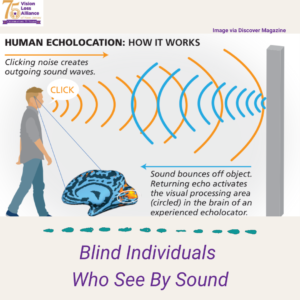Echolocation is shared by many species, including whales and dolphins – even people can learn how to use it!
Now, new research shows that both sighted people and those who are blind can learn how to echolocate using clicking noise, either from one’s own mouth, footsteps, or walking cane taps, after just 10 weeks of training.
Read more on this interesting topic as shared by journals.plos.org here: https://bit.ly/humanecholocation

The VLANJ logo and an image via Discover Magazine depicting how human echolocation works is featured, with text that reads: “Human Echolocation: How It Works. Clicking noise creates ongoing sound waves. Sound bounces off object. Returning echo activates the visual processing area (circled) in the brain of an experienced echolocator.” Text below reads: “Blind Individuals Who See By Sound.”
